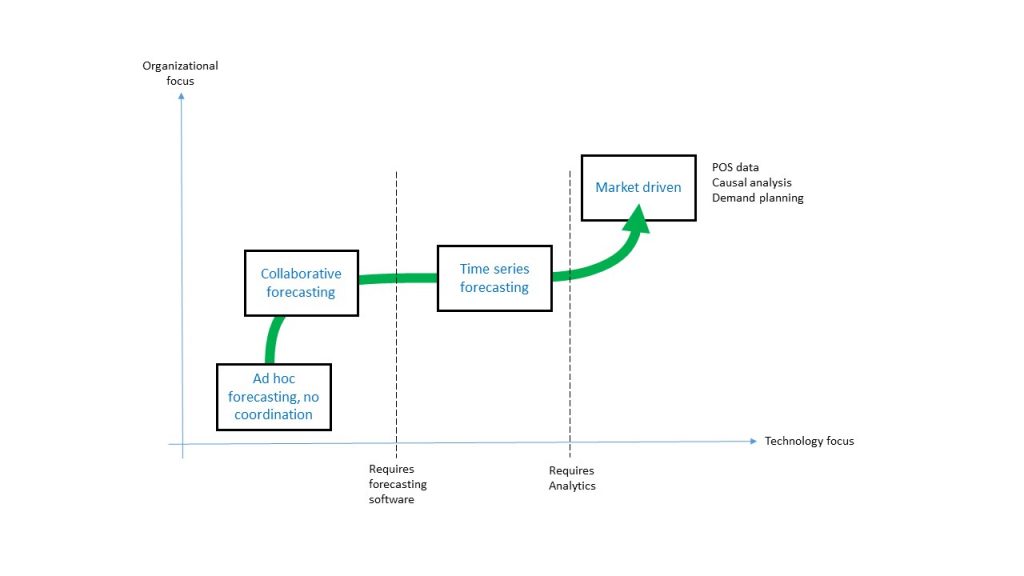This is the second post of a series about the market driven journey to demand driven forecasting. You can read my first post Supply chain transparency: The market driven journey here. If you are interested to know more about demand driven forecasting and planning taking demand responsiveness to the next level, you can download a White Paper about taking demand responsiveness to the next level.
Being market driven boils down to three things:
- Knowing the true market demand and the demand drivers
- Having a supply chain that can respond to the true demand
- Having processes in place to align demand and supply on day-to-day AND long term basis.
To become market driven, companies often follow the journey depicted below with development on both organizational and technical areas. I explored the early maturity levels in my previous post.
Knowing the true market demand
The ability to know what the market will purchase from you is of course a critical el ement in being market driven and – as explained in the previous article – the element that actually drives companies onto the market driven journey.
ement in being market driven and – as explained in the previous article – the element that actually drives companies onto the market driven journey.
On the journey through collaborative forecasting and time series forecasting, companies realize that demand changes as the drivers of demand change – e.g. pricing, campaigning or events in the marketplace that the company cannot control. Knowing the true demand starts with knowing what drives the market – i.e. what makes customers purchase the company’s products – the demand drivers. The typical way to handle demand drivers is to guesstimate the impact of demand drivers and manually adjust the sales history – identifying the baseline demand, which is easily forecasted. After creating the baseline forecast –the effect on demand from the demand drivers is added.
However, this is a short-term solution. The marketplace is complex, and the judgmental analysis proves too simple to raise the forecast accuracy.
Market driven forecasting
Changing from time-series forecasting to market driven is to start using statistics to analyze the impact of the demand drivers instead of guessing the impact. It is to move from a judgmental to a causal forecasting approach. Demand drivers are used as causal factors alongside the sales history when generating the forecast. In market driven forecasting the company is not satisfied with knowing how many products it will sell – but seeks to know the conditions and circumstances leading to the sales and ultimately ask for an answer to why and when a customer buys the company’s products.
This higher level of understanding moves the company away from making the traditional forecast overrides and into creation of scenarios by changing demand driver values – i.e. working with the premises for the forecast – not the result, e.g. by adding events, altering prices etc. The stakeholders of the forecast validate the demand scenarios to ensure that they are feasible and acceptable. The outcome of the process is thus not only the forecast itself, but plans for how to reach it and – from operations side – fulfill it.
To do market driven forecasting you need data – many data. The market driven forecasting process builds on Demand Signal Analytics (DSA), which is the ability to collect and analyze large amounts of data to uncover their potential use as demand drivers. DSA is a prerequisite for market driven forecasting. Market driven forecasting builds on statistics and planning rather than guesstimates. However qualified these guesstimates are – thoroughly analyzing data to understand the past and plan the future will reduce uncertainty in the forecast.
Building a market driven forecasting process
Market driven forecasting requires changes in both the technological and organizational areas compared to time-series forecasting.
Technologically the software should support the new processes – i.e. collect, store and analyze data – make scenarios and of course do the forecasting based including demand drivers – also called: Independent variables.
However – in my opinion, the most exciting technological challenge that arises when running market driven forecasting is the need for speed. As creating valid scenarios is at the core of market driven forecasting – running forecasts, as a nightly batchjob is not enough. Scenario creation requires that forecasts are generated ad hoc – and multiple times during the forecasting process – each time adjusting demand driver values.
Organizationally – new competencies and processes are needed. The demand planner is still at the heart of the process – now creating scenarios and handling data. Next to him – a new role as Demand Analyst is created – to continually analyse and uncover demand driver relationships. The organization becomes even more integrated. Creating scenarios requires understanding of cross company opportunities and constraints – which again requires companies to break down silos and implement a process oriented way of working.
The road to market driven forecasting
Maturing your forecasting process towards becoming market driven first and foremost requires the will and commitment of those involved in the forecasting process. This requires that they know the vision and can see the value of being data driven in the forecasting process.
It is not a revolution in how the forecasting process is perceived in the company. It builds on top of the earlier maturity stages and adds the power of Analytics to the process in order to document the circumstances and conditions leading to the expected demand. The biggest change is in realizing that data will do a better job of predicting effects of campaigns and pricing than the combined knowledge of the forecast stakeholders and that purposely biasing the forecast is no longer an option.
Other posts on the series:
Supply chain transparency: The market driven journey
The market driven journey III – the market driven supply chain
Join the conversation
We organize a Tweetchat on the topic “Why pursue Supply Chain Transparency” on Friday 16th December at 15:00 CET. There you can meet Hans and other experts, give your comments on these questions:
The questions:
Q1 What are the most significant benefits of transparency in supply chains?
Q2 What are the typical barriers to achieving transparency?
Q3 How will IoT and the promise of Industry 4.0 simplify or complicate the pursuit of transparency?
Q4 How can manufacturers become more data and analytics driven?
Q5 What lessons can we take from early adopters of analytics for supply chain transparency?
Use #SASchat and your are part of the conversation!



5 Comments
It is evidently clear that ordinary time series or seasonal decomposition through moving average, is not best way to forecast. Market driven factors need to ascertained which in turn help marketing managers to forecast based on demand pull factors.
Thank you for your observation. Any thoughts to why - with so great evidence that Analytics & causal forecasting can help reduce uncertainty in the forecast - companies are still struggling to move beyond Excel spreadsheets or traditional time-series forecasting?
Hi Here is a related article about Demand Forecasting https://www.bizacuity.com/understanding-demand-forecasting-mastering-it/ hope it will be interesting for you. Thank you!
Great information thanks for sharing ...
Here is a related article about Demand Forecasting https://www.bizacuity.com/understanding-demand-forecasting-mastering-it/ hope it will be interesting for you. Thank you!
Thank you for your comment and link. I believe that the message of using causal factors in your forecast will be heard in the coming years and lead to an increased use within Forecasting and Replenishment processes.